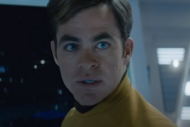Create a free profile to get unlimited access to exclusive videos, sweepstakes, and more!
Star Trek: Discovery explains the low-tech '60s vibe of the original show with a weird canon twist

The latest episode of Star Trek: Discovery — “An Obol for Charon” — is jam-packed with tons of twists and turns, including not one but two different misunderstood aliens threatening the ship, not to mention major drama for Saru. Like the previous episode, it was a lot to take in, which means you’ll be forgiven if you missed the huge canon retcon that was slipped into the opening moments of the episode.
In one very brief exchange, Captain Pike basically retconned all the sleek, high-tech aesthetic of Star Trek: Discovery and reconciled it with the ‘60s style of the original series. For fans who have been wondering how the high-tech world of Discovery morphs into the low-tech world of the original Trek, we now have an answer. Captain Pike seemingly caused an intentional tech downgrade across all of Starfleet. Let’s get into it.
**SPOILER WARNING! Spoilers ahead for Star Trek: Discovery Season 2, Episode 4, “An Obal for Charon.”**
When Number One (Rebecca Romijn) visits Captain Pike on the USS Discovery at the top of the episode, she gives Pike a quick update on the repairs on the USS Enterprise. With seemingly little evidence, Pike decides that one of the reasons the Enterprise went offline was that the “damn holographic com system” was glitchy. He tells Number One to have the engineer “rip out the entire system” and says that “from now on we’ll communicate using good old-fashioned view screens.”
Whoa! So, right there, there’s a very clear answer as to why the classic Enterprise in the original series doesn’t have the holographic interface, which was such a big deal in the first season of Discovery. But here’s the thing. Pike’s anti-hologram bias coupled with his experiences in this season of Discovery suggests that having the holograms ripped out of the Enterprise is just the beginning of a huge technical downgrade across all of Starfleet. How, you might ask? Well, at this point in Trek history, 2257 Pike is just one captain in Starfleet. But, according to original episode “The Menagerie” (which happens in 2265), Pike has been made fleet captain. This means that in between the time of Discovery and the start of the original series, Pike could conceivably wield a ton of influence over how the entire fleet runs its ships, and it stands to reason that he institutes a minimalist philosophy when it comes to how starships function.
Think of Pike as the Marie Kondo of the Star Trek universe. If he thinks there are too many techy bells and whistles on a starship, he’s going to ask for those bells and whistles to be removed. Which is why the holograms might be the beginning of Pike’s insistence that starships become slightly more analog after the time of Discovery.
Case in point: In this episode, the failure of the universal translator has several terrible effects, but the one impact that’s most relevant is probably the one you didn’t notice. When Burnham needs to head to engineering, Saru says she will “need a translator just to operate the turbolift.” The turbolift is the fancy Star Trek version of an elevator and is the primary way people get around on the ship. And it looks like that at this point in time, the turbolift runs on voice commands only. Meaning the only way for Burnham to get where she needs to go is to be able to talk to it, and because those voice commands are broken, she can’t. This would be like if your car ran on Alexa, and you suddenly didn’t have Wi-Fi service. Which is where things get interesting.
In the original Star Trek — which, again, is in the future for Discovery — the turbolifts aren’t voice-activated. At all. Instead, Kirk, Spock, and Bones use a little handle to presumably tell the turbolift where they want to go. By the time of The Next Generation and Deep Space Nine (100 years after Discovery and TOS), turbolifts are back to being voice-activated, a fact that is so ingrained in people’s lives that when O’Brien and Bashir time-travel to the old-school Enterprise in the DS9 episode “Trials and Tribble-ations,” they don’t actually know how to use the turbolifts without voice commands.
The joke that Star Trek people are so used to talking to computers instead of just punching buttons on a keyboard is perhaps best exemplified in the film Star Trek IV: The Voyage Home, in which Scotty tries to talk to a 1986 Apple computer by speaking into the mouse. (Scotty is also vaguely referenced in this episode when Pike suggests the Enterprise will never have a more loving chief engineer.) Also, you could argue that the entire plot of “An Obol for Charon” is a riff of The Voyage Home insofar as both have stories about giant alien probes that seem destructive, but are really just trying to communicate.
Anyway, the point is that in just one episode of Discovery, Captain Pike encounters two technologically sophisticated starship features that actually prove to be a pain in the ass: holograms and voice-activated turbolifts. So, when he becomes fleet captain at some point after (or during?) this season of Discovery, it’s almost guaranteed that he’ll go on a tech-downgrading spree, which will result in all the minimalist, pushbutton starships of the original series.
As retcons go, this one is perhaps the most delightful, because not only does it make sense, it also offers some subtle social commentary. Discovery might look slicker and cooler than the TOS version of the Enterprise, but in the realm of science fiction, does it actually accomplish more? In theory, Kirk’s five-year mission puts the Enterprise in deep space (at least for a little while) boldly going where no one has gone before. And while they’re doing that, they need starship tech that is reliable and durable, even if it does look a little clunky.




























